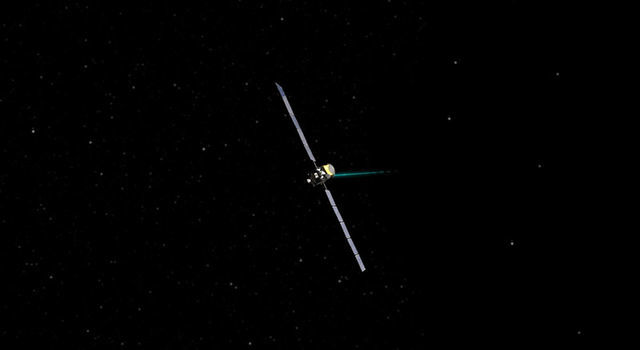News | November 20, 2008
Dawn Glides Into New Year

NASA's Dawn spacecraft shut down its ion propulsion system today
as scheduled. The spacecraft is now gliding toward a Mars flyby
in February of next year.
"Dawn has completed the thrusting it needs to use Mars for a gravity assist to help get us to Vesta," said Marc Rayman, Dawn's chief engineer, of NASA's Jet Propulsion Laboratory, Pasadena, Calif. "Dawn will now coast in its orbit around the sun for the next half a year before we again fire up the ion propulsion system to continue our journey to the asteroid belt."
Dawn's ion engines may get a short workout next January to provide any final orbital adjustments prior to its encounter with the Red Planet. Ions are also scheduled to fly out of the propulsion system during some systems testing in spring. But mostly, Dawn's three ion engines will remain silent until June, when they will again speed Dawn toward its first appointment, with asteroid Vesta.
Dawn's ion engines are vital to the success of the misson's 8-year, 4.9-billion-kilometer (3-billion-mile) journey to asteroid Vesta and dwarf planet Ceres. One of these extremely frugal powerhouses can generate more than 24 hours of thrusting while consuming about .26 kilograms (about 9 ounces) of the spacecraft's xenon fuel supply -- less than the contents of a can of soda. Over their lifetime, Dawn's three ion propulsion engines will fire cumulatively for about 50,000 hours (over five years) -- a record for spacecraft.
Dawn will begin its exploration of asteroid Vesta in 2011 and the dwarf planet Ceres in 2015. These two icons of the asteroid belt have been witness to so much of our solar system's history. By utilizing the same set of instruments at two separate destinations, scientists can more accurately formulate comparisons and contrasts. Dawn's science instrument suite will measure shape, surface topography, tectonic history, elemental and mineral composition, and will seek out water-bearing minerals. In addition, the Dawn spacecraft itself and how it orbits both Vesta and Ceres will be used to measure the celestial bodies' masses and gravity fields.
The Dawn mission to asteroid Vesta and dwarf planet Ceres is managed and operated by JPL for NASA's Science Mission Directorate, Washington, D.C. The University of California, Los Angeles, is responsible for overall Dawn mission science. Other scientific partners include: Max Planck Institute for Solar System Research, Katlenburg, Germany; DLR Institute for Planetary Research, Berlin, Germany; Italian National Institute for Astrophysics, Rome; and the Italian Space Agency. Orbital Sciences Corporation of Dulles, Virginia, designed and built the Dawn spacecraft.
Additional information about Dawn is online at http://www.nasa.gov/dawn and http://dawn.jpl.nasa.gov.
"Dawn has completed the thrusting it needs to use Mars for a gravity assist to help get us to Vesta," said Marc Rayman, Dawn's chief engineer, of NASA's Jet Propulsion Laboratory, Pasadena, Calif. "Dawn will now coast in its orbit around the sun for the next half a year before we again fire up the ion propulsion system to continue our journey to the asteroid belt."
Dawn's ion engines may get a short workout next January to provide any final orbital adjustments prior to its encounter with the Red Planet. Ions are also scheduled to fly out of the propulsion system during some systems testing in spring. But mostly, Dawn's three ion engines will remain silent until June, when they will again speed Dawn toward its first appointment, with asteroid Vesta.
Dawn's ion engines are vital to the success of the misson's 8-year, 4.9-billion-kilometer (3-billion-mile) journey to asteroid Vesta and dwarf planet Ceres. One of these extremely frugal powerhouses can generate more than 24 hours of thrusting while consuming about .26 kilograms (about 9 ounces) of the spacecraft's xenon fuel supply -- less than the contents of a can of soda. Over their lifetime, Dawn's three ion propulsion engines will fire cumulatively for about 50,000 hours (over five years) -- a record for spacecraft.
Dawn will begin its exploration of asteroid Vesta in 2011 and the dwarf planet Ceres in 2015. These two icons of the asteroid belt have been witness to so much of our solar system's history. By utilizing the same set of instruments at two separate destinations, scientists can more accurately formulate comparisons and contrasts. Dawn's science instrument suite will measure shape, surface topography, tectonic history, elemental and mineral composition, and will seek out water-bearing minerals. In addition, the Dawn spacecraft itself and how it orbits both Vesta and Ceres will be used to measure the celestial bodies' masses and gravity fields.
The Dawn mission to asteroid Vesta and dwarf planet Ceres is managed and operated by JPL for NASA's Science Mission Directorate, Washington, D.C. The University of California, Los Angeles, is responsible for overall Dawn mission science. Other scientific partners include: Max Planck Institute for Solar System Research, Katlenburg, Germany; DLR Institute for Planetary Research, Berlin, Germany; Italian National Institute for Astrophysics, Rome; and the Italian Space Agency. Orbital Sciences Corporation of Dulles, Virginia, designed and built the Dawn spacecraft.
Additional information about Dawn is online at http://www.nasa.gov/dawn and http://dawn.jpl.nasa.gov.


